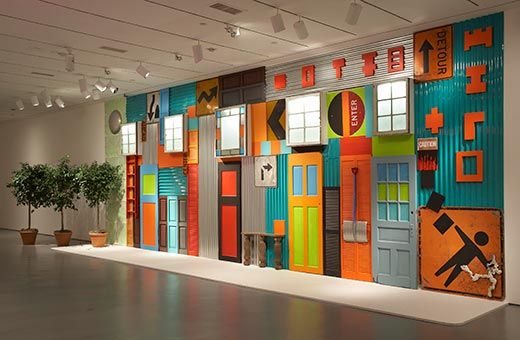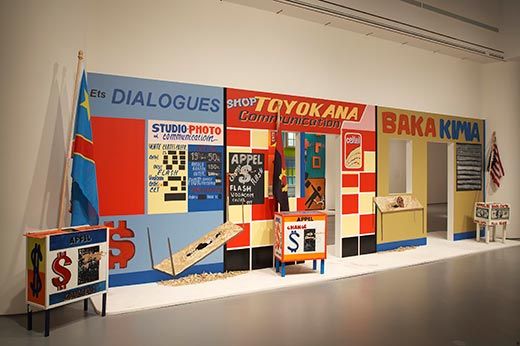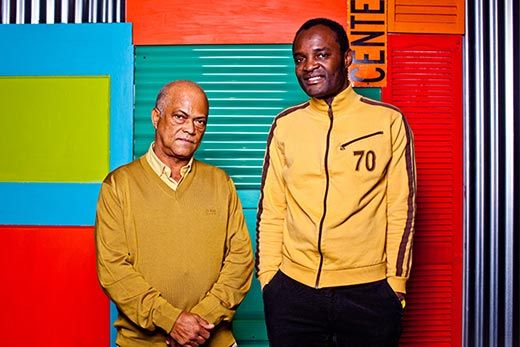Across Africa, Finding Common Ground in Their Art
António Ole and Aimé Mpane came together to converse through artwork in a new insallation at the National Museum of African Art
/https://tf-cmsv2-smithsonianmag-media.s3.amazonaws.com/filer/Antonio-Ole-and-Aime-Mpane-National-Museum-African-Art-631.jpg)
António Ole, 57, from Angola, and Aimé Mpane, 40, from the Democratic Republic of Congo, created multimedia installations as part of an artistic dialogue on view at the Smithsonian National Museum of African Art. The exhibition, on view through August 2, is the first in a series from the museum in which contemporary artists are asked to create work in response to each other.
The pair spoke about their individual work and the collaborative process with Smithsonian’s Joseph Caputo.
Why is this dialogue important?
Mpane: The human being doesn’t live alone--he lives in contact. You will not progress if you’re just by yourself. You must have a dialogue anyhow and anywhere. In Africa there’s dialogue all the time, especially when things are going wrong. We don’t have therapists, we have the whole extended family and we put a matter to anyone who’ll provide a word on it. Then we must find a solution. This very act of creating together is an example of how to develop new ideas.
Before this exhibit, you barely knew one another. What kind of ground did you have for conversation?
Ole: I think this conversation happened because we are neighbors. We share a big border north of Angola and south of Congo. There are a lot of people that are part of the same ethnic group that barely respond to this division. This is the consequence of the Berlin Conference [1884] that divided Africa into these straight lines that most of the time divided families. From this we started sharing ideas.
What has this dialogue taught you?
Ole: I don’t think artists know everything. The most important thing is sharing experiences. It’s an immense pleasure to work with Aimé because, even though he comes from another generation than mine, I have the impression that he’s a good human being, putting humanity inside his painting and sculpture. I also learn a lot from him. I’m not capable of doing what he does. I think I’ve become richer after this meeting.
What story does the exhibit’s dialogue tell?
Mpane: Of course, there’s a story because you have to start from nothing to arrive at this point. When I arrived, I came with a definite idea, but the final result was the product of conversation, negotiation and experiencing together. So, if you take a close look at the wall. On Antonio’s side you just see one sign: Open. It’s a very clear message. Just enter, open your mind. We created an opening to each other.
How is your work shaped by life in Africa?
Mpane: I was asked by a University of Maryland student, ‘What kind of piece are you going to do tomorrow?’ I said, ‘Even before thinking about tomorrow, let’s live the moment.’ I believe that to think like that comes from living in poverty or exposed to poverty. Those conditions enable me to live with a lot of intensity and not think about tomorrow. That’s what you see in the exhibition. That’s what I do with my art.
One of the stereotypes about Africa is that there is only bad news. How does your art work against that stereotype?
Ole: For me, this is an important issue, because if something positive happens, the press never pays attention.
Mpane: It’s true that we only mention the negative aspect of this country and that’s a reality. But every civilization has gone through difficult periods. I try to be positive and make something with what I have. Even in a place where there is nothing, we will still produce art. It makes us stronger.
/https://tf-cmsv2-smithsonianmag-media.s3.amazonaws.com/accounts/headshot/joseph-caputo-240.jpg)



/https://tf-cmsv2-smithsonianmag-media.s3.amazonaws.com/accounts/headshot/joseph-caputo-240.jpg)